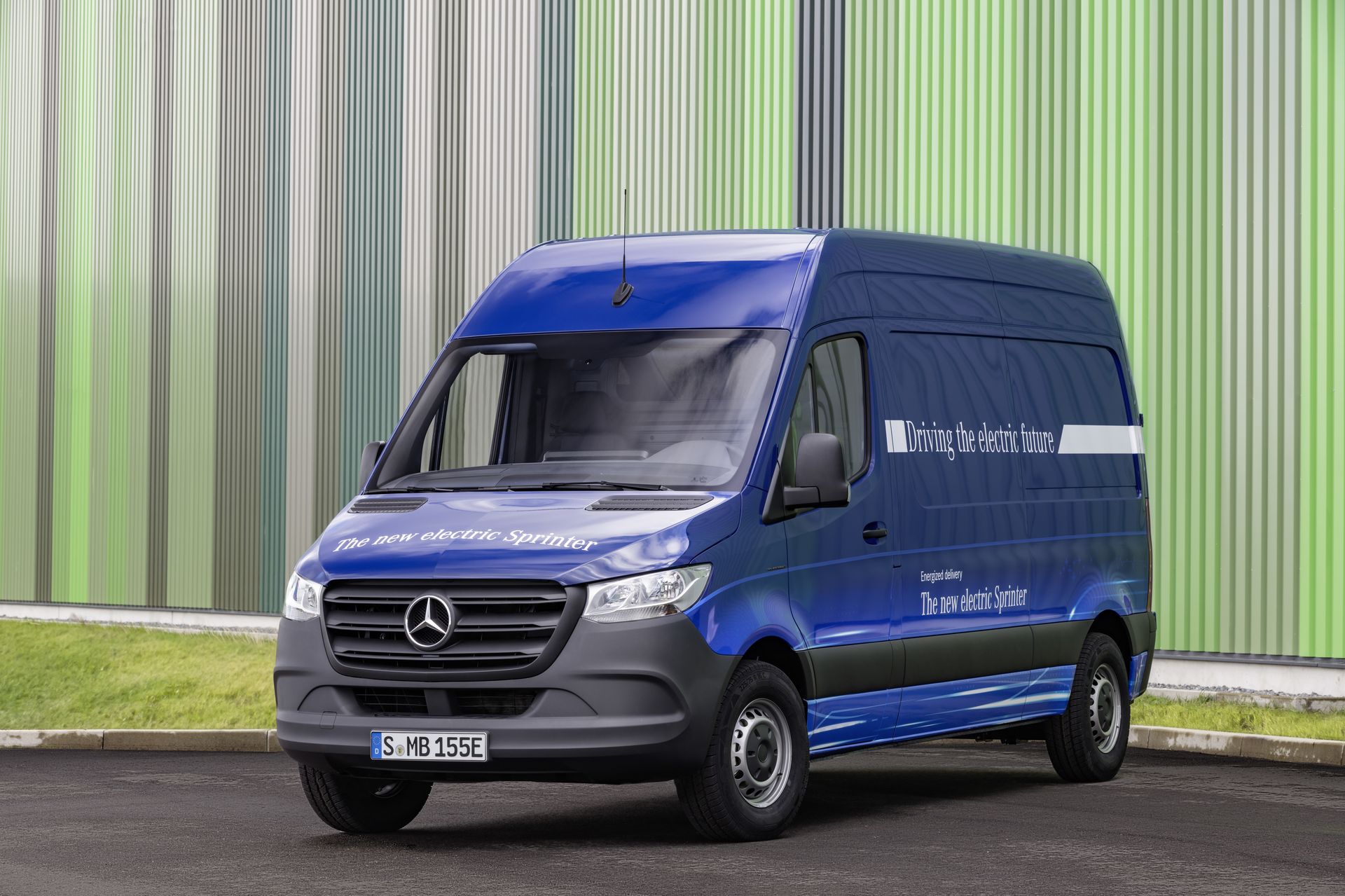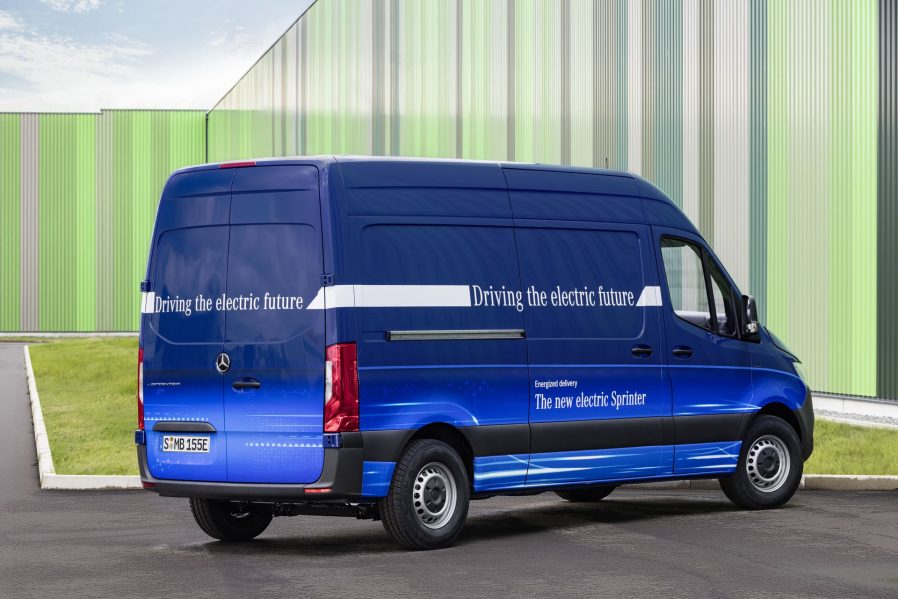Mercedes-Benz Releases eSprinter Electric Van Specs
After the general presentation in February, Mercedes-Benz just released specs for the upcoming eSprinter model.
Khodrocar - M-B’s second commercial all-electric model (the first was eVito, while the third will be eCitan) is scheduled for production in 2019.
There will be two battery options – 41 kWh and 55 kWh.
The 41 kWh (like in eVito) will be able to drive up to 115 km (71.5 miles) under unfavorable conditions such as low ambient temperatures and a full load (of up to 1,040 kg or up to 10.5 m3 depending on version). The bigger battery provides range of up to 150 km (93 miles) under unfavorable conditions, but takes 140 kg of the payload, so only up to 900 kg will be possible.
Charging takes 6 or 8 hours using the 7.2 kW on-board charger or 45 minutes using a DC Combo charger.
The powertrain seems the same as in the eVito – 80 kW and 300 Nm electric motor, which is strong enough to go 80 km/h (50 mph), or even 120 km/h if needed.
eSprinter: Systematic electrification of commercial fleets: from 2019 the eSprinter will add to the drive portfolio
Maximum range of up to 150 km or maximum payload of over 1000 kg: customers have the choice with two battery options
3.5-tonne panel van with load capacity of up to 10.5 m3
Goal of the electromobility strategy of Mercedes-Benz Vans: all-round eco-system with an individual customer approach
Systematic implementation of the eDrive@VANs strategy also in the Sprinter segment: as the second model in the commercial fleet, Mercedes-Benz Vans is equipping the new Sprinter with an electric powertrain. In 2019 the new eSprinter will enter the market as a follow-up to the eVito. The mid-size van has been available to order for a number of months, and the first examples will be delivered in the second half of this year. Over the next few years Mercedes Benz Vans will also offer every commercial model range as an electric variant.
There will be two battery options – 41 kWh and 55 kWh.
The 41 kWh (like in eVito) will be able to drive up to 115 km (71.5 miles) under unfavorable conditions such as low ambient temperatures and a full load (of up to 1,040 kg or up to 10.5 m3 depending on version). The bigger battery provides range of up to 150 km (93 miles) under unfavorable conditions, but takes 140 kg of the payload, so only up to 900 kg will be possible.
Charging takes 6 or 8 hours using the 7.2 kW on-board charger or 45 minutes using a DC Combo charger.
The powertrain seems the same as in the eVito – 80 kW and 300 Nm electric motor, which is strong enough to go 80 km/h (50 mph), or even 120 km/h if needed.
eSprinter: Systematic electrification of commercial fleets: from 2019 the eSprinter will add to the drive portfolio
Maximum range of up to 150 km or maximum payload of over 1000 kg: customers have the choice with two battery options
3.5-tonne panel van with load capacity of up to 10.5 m3
Goal of the electromobility strategy of Mercedes-Benz Vans: all-round eco-system with an individual customer approach
Systematic implementation of the eDrive@VANs strategy also in the Sprinter segment: as the second model in the commercial fleet, Mercedes-Benz Vans is equipping the new Sprinter with an electric powertrain. In 2019 the new eSprinter will enter the market as a follow-up to the eVito. The mid-size van has been available to order for a number of months, and the first examples will be delivered in the second half of this year. Over the next few years Mercedes Benz Vans will also offer every commercial model range as an electric variant.

The Sprinter and eVito follow the same strategic principles: customer benefits and maximum day-to-day suitability are the central development focus. To this end, Mercedes-Benz Vans is placing its faith in a comprehensive eco-system. The creation of a suitable charging infrastructure, allowance for application-specific driving parameters, local servicing and the integration of intelligent connectivity services make the eSprinter an end-to-end system solution for commercial operations. Hence both conventional and electric drive system are on equal terms at economic efficiency, flexibility and variability.
Competitive – also in larger vehicle classes
"Electrification of the commercial fleet follows our conviction that the future belongs to electric drive systems, especially in inner-city traffic. We have already shown with the eVito that we are serious about the implementation. Now we are going a step further with the eSprinter. Our electric drive systems are also competitive in larger vehicle segments – especially regarding the total cost of ownership which is important for our commercial costumers”, says Volker Mornhinweg, Head of Mercedes-Benz Vans.
The new eSprinter will be available as a panel van with high roof. With a permissible gross vehicle weight of 3500 kilograms, a vehicle length of 5932 millimetres, a wheelbase of 3924 millimetres and a maximum load capacity of 10.5 m3, the eSprinter has sufficient space for a wide range of transport requirements. Maximum flexibility is ensured by a choice of battery capacities. With an installed battery capacity of 55 kWh, the range of the new eSprinter is around 150 kilometres, even under unfavourable conditions such as low ambient temperatures and a full load. The batteries can be fully charged in eight hours at a charge column or a wallbox with a maximum power of 7.2 kW. In this configuration the maximum payload is around 900 kilograms, mainly aimed at customers who also use their vehicles over longer distances in urban areas but rarely load them to the payload limit. A second battery capacity option above all meets inner-city operating requirements where range is of secondary importance but payload capacity is a decisive criterion. In this case the installed battery capacity is 41 kWh, and the range is around 115 kilometres. In return the maximum payload increases by around 140 kilograms to around 1040 kilograms. The charging time is around six hours, unless the eSprinter is charged at a DC fast charging station, then when using the corresponding charging capacity, after 45 minutes both battery capacities will be provided with 80 percent of their range again.

The performance figures also show that the Sprinter and the eSprinter are eye-to-eye. Like the entry-level diesel variant, the electric drive system has an output of 84 kW and a torque of up to 300 newton metres. Customers have a choice of maximum speeds: in city traffic and densely populated areas, a top speed of 80 km/h meets all requirements while conserving energy reserves and increasing range. If more pace is required, top speeds of up to 120 km/h are possible.
From passenger services to goods transport – with its electrically powered model range Mercedes-Benz Vans plans to electrify all commercially used vans. Accordingly the eVito and the eSprinter will be followed by the eCitan to complete the range. Vehicle development itself is just a part of the Mercedes-Benz Vans electromobility strategy. One of the major aims is the integration of modern vehicle technology into an overall eco-system. To this end the experts at Mercedes-Benz Vans are developing a tailor-made operating concept in dialogue with customers. The needs of individual business sectors are taken into consideration, as are fleet size, the driving profile or the structural requirements in establishing a dedicated charging infrastructure at the company’s site. Electric drive-specific connectivity solutions, as well as financing and mobility concepts, are also taken into account in the early planning phase. Comprehensive maintenance and service management rounds off the package.
"The total operating costs must be at the level of a comparably equipped vehicle powered by a diesel engine – the eSprinter and the eVito meet this basic requirement. Electric models can only be competitive in commercial operations if using them makes economic sense. The higher procurement costs are offset by lower energy and maintenance costs, as well as tax savings,” says Benjamin Kaehler, Head of eDrive@VANs at Mercedes-Benz Vans.
Know-how and technology transfer from the Daimler group
The fast development pace is made possible by the transfer of expertise and technology within the Daimler group. Modular components from passenger car development are also used in the vans. Synergies in the passenger car and commercial vehicle sectors ensure a high development speed, and customers benefit from the high maturity of the components used. In addition to investments in other corporate areas, Mercedes-Benz Vans is investing 150 million euros in the electrification of its commercial fleet over the next few years. The Mercedes-Benz Vans electromobility strategy is part of the strategic future initiative adVANce, presented in autumn 2016. This is driving the company’s transition from purely a vehicle manufacturer to a provider of end-to-end mobility solutions. By 2020, under the aegis of adVANce, Mercedes-Benz is investing around 500 million euros in the integration of different connectivity solutions into vans, innovative hardware solutions for the transport sector and new mobility concepts, among other areas.
Source: InsideEVs
Latest News


